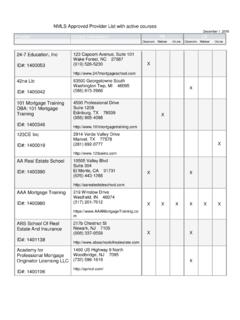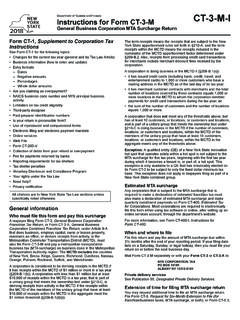Transcription of Snakes in Connecticut
1 SNAKESin ConnecticutA Guide to SnakeIdentificationConnecticut Department ofEnvironmental ProtectionBureau of Natural ResourcesWildlife DivisionIntroductionHundreds of Snakes are needlessly killedeach year because of mistaken identity, fear,and misunderstanding. Very often when asnake is found near a home, people panicand may even assume that the snake isdangerous or venomous. Few Connecticutresidents realize that they are unlikely toencounter a venomous snake around theirhome. The two venomous snake speciesfound in Connecticut , the timber rattlesnakeand the copperhead, do not have widespreaddistributions.
2 These venomous Snakes ,along with the other 12 Connecticut snakespecies, are not aggressive and will only biteif threatened or handled. If left alone, Snakes pose no threat to Wildlife Division has developed thissnake identification guide to help educatepeople about Snakes , thereby minimizingunwarranted concern when a snake isencountered. The Division hopes that oncepeople are able to properly identify thesnakes that live in and around their homes,they will be more understanding andtolerant of these beneficial animals. Theguide also includes information on snakecontrol and who to contact for of ConnecticutSnakesSnake populations in Connecticut havedeclined because of habitat loss,unnecessary persecution, and road collection for the pet trade is anotherproblem, where the removal of even oneanimal from the wild can be detrimental toan imperiled species like the timberrattlesnake.
3 The following species areprotected in Connecticut . Contact theWildlife Division for additional Endangered Timber RattlesnakeSpecies of Special Concern Eastern RibbonsnakeEastern Hog-nosed SnakeState Regulated Eastern RatsnakeHow to Use this GuideThe Snakes in this guide are grouped inorder of general appearance. Locate apicture that resembles the snake you aretrying to identify. Check the map and thehabitat description to determine if thespecies of snake actually occurs in yourarea. For each species there is a listing ofkey characteristics that will help youdistinguish the snake from similar-appearingspecies.
4 Each snake description includeswhether the species has smooth or keeledscales. Keeled scales have a raised ridgealong their center and give the snake s skin arough appearance when viewed confusing species listing provides aquick reference to Snakes that are most oftenmistaken for one GartersnakeThamnophis s. sirtalisSize:16 to 42 inchesLOOK FOR: Three light yellow or white stripes running thelength of the body; dark body with white flecks Yellowish-green or bronze belly; darker alongedges Keeled scalesDiet:Earthworms, frogs, toads, salamanders, fishHabitat:Found everywhere from moist areas toforest edges to vacant lots to backyardsConfusing Species:Eastern RibbonsnakeDistribution:3P.
5 FUSCOE astern RibbonsnakeThamnophis s. sauritusSize:20 to 32 inchesLOOK FOR: Three well-defined yellow-orange stripes runningthe length of a slender, dark brown body Long, thin tail Keeled scalesDiet:Insects, fish, salamanders, frogs, toadsHabitat:Shallow water, grassy or shrubby areasbordering streams, and wooded swampsConfusing Species:Common GartersnakeDistribution:4G. HAMMERSONS mooth GreensnakeOpheodrys vernalisSize:12 to 25 inchesLOOK FOR: Brilliant green color Thin body Smooth scalesDiet:Spiders and insectsHabitat:Old fields, pastures, meadows, edges ofwetlandsConfusing Species: NoneDistribution:5P.
6 FUSCO6 Eastern WormsnakeCarphophis a. amoenusSize:7 to 14 inchesLOOK FOR: Small size; worm-like in appearance Glossy brown-gray body with pink belly; stubbytail with pointed tip Smooth scalesDiet:Primarily earthwormsHabitat:Well-drained soil, usually near deciduouswoodlands; occasionally gardensConfusing Species: Red-bellied SnakeDistribution:P. FUSCOD ekay s BrownsnakeStoreria d. dekayiSize:9 to 15 inchesLOOK FOR: Small size; two rows of dark spots along the lengthof back; tan body Young Snakes have white neck-ring and darkerbody Keeled scalesDiet:Insects, earthworms, small treefrogsHabitat:Disturbed areas; common in urbanlocationsConfusing Species: Red-bellied SnakeDistribution:7P.
7 FUSCO8 Red-bellied SnakeStoreria o. occipitomaculataSize:8 to 11 inchesLOOK FOR: Brown or gray body with bright red or orangebelly Small size; light-colored neck spots Keeled scalesDiet:Insects, slugs, earthwormsHabitat:Moist woodlands; under debris in openareasConfusing Species:Dekay s Brownsnake, Ring-necked Snake, Eastern WormsnakeDistribution:P. FUSCORing-necked SnakeDiadophis punctatus edwardsiiSize:9 to 25 inchesLOOK FOR: Dull blue-gray body; yellow neck ring; brightyellow belly, sometimes with black spots Small size and thin body Smooth scalesDiet:Small salamanders, earthwormsHabitat:Diverse; sand barrens to gardens tomeadows to forests; occasionally found in basementsConfusing Species:Young Dekay s BrownsnakeDistribution:9P.
8 FUSCO10 Northern WatersnakeNerodia s. sipedonSize:25 to 52 inchesLOOK FOR: Cream-colored belly is patterned with bright,reddish half-moons Body coloration variable; uniformly dark or withalternating bands of brown and gray; banding ismore visible in young Snakes Keeled scalesDiet:Fish, insects, frogs, toadsHabitat:Aquatic and semi-aquatic areas;frequently found along dams and in streams, lakes,and marshesConfusing Species:CopperheadDistribution:G. HAMMERSONG. HAMMERSONM ilksnakeLampropeltis t. triangulumSize:19 to 40 inchesLOOK FOR: Y- or V-shaped mark on top of head Whitish-gray body with blotches of red/brown andtan on back; blotches have black borders; blackand white checkerboard pattern on belly Smooth scalesDiet:Mice, small mammals, Snakes , birdsHabitat:Varied, from urban areas to found under cover (logs, stones, boards,etc.)
9 Or along stone walls in open fields. Also foundaround old Species:Copperhead, young EasternRatsnake, young Eastern Racer, young NorthernWatersnakeDistribution:11P. FUSCOC opperheadAgkistrodon contortrix mokasenVENOMOUS SPECIESSize:24 to 37 inchesLOOK FOR: Stocky copper-colored body; brown or reddishbands that are wide on sides and narrow on back;belly pink with darker marks Head appears wider than neck; copper-coloredeye; large pits between eyes and nostrils Young same as adults, but with a yellowish tail tip Keeled scalesDiet:Mice and other rodents, insects, small birds,frogsHabitat:Basalt ridges, talus slopes, rocky hillsides,open woods.
10 Edges of swamps and meadowsConfusing Species: Milksnake, NorthernWatersnake, Eastern Hog-nosed SnakeDistribution:12 Young copperheadP. FUSCOJ. DICKSONE astern Hog-nosedSnakeHeterodon platirhinosSize:21 to 32 inchesLOOK FOR: Blunt, upturned nose May hiss, flatten its body, spread its neck hood,and/or roll over on its back and play dead Stout body; highly variable coloration; alternatinglight and dark blotches, including combinations ofbrown, yellow, and reddish-orange. A solid gray-black phase is also found in Connecticut . Keeled scalesDiet:Mostly toads; occasionally frogs, salamandersHabitat:Sandy, gravelly, well-drained soils; alsodry areas along second-growth deciduous forestsConfusing Species:Copperhead, TimberRattlesnakeDistribution:Black phasePlaying dead13P.















